Enron: Analysis of downfall and IFRS vs US GAAP comparison
VerifiedAdded on 2023/06/06
|10
|2696
|395
AI Summary
This article provides an analysis of the downfall of Enron and a comparison between IFRS and US GAAP. It covers topics such as mark-to-market accounting, special purpose entities, and stock options. The article also includes a comparison of financial statement elements and measurement techniques used by Wesfarmer Group Limited and Mackay Golf Club.
Contribute Materials
Your contribution can guide someone’s learning journey. Share your
documents today.

qwertyuiopasdfghjklzxcvbnmqwerty
uiopasdfghjklzxcvbnmqwertyuiopasd
fghjklzxcvbnmqwertyuiopasdfghjklzx
cvbnmqwertyuiopasdfghjklzxcvbnmq
wertyuiopasdfghjklzxcvbnmqwertyui
opasdfghjklzxcvbnmqwertyuiopasdfg
hjklzxcvbnmqwertyuiopasdfghjklzxc
vbnmqwertyuiopasdfghjklzxcvbnmq
wertyuiopasdfghjklzxcvbnmqwertyui
opasdfghjklzxcvbnmqwertyuiopasdfg
hjklzxcvbnmqwertyuiopasdfghjklzxc
vbnmqwertyuiopasdfghjklzxcvbnmq
wertyuiopasdfghjklzxcvbnmqwertyui
opasdfghjklzxcvbnmqwertyuiopasdfg
hjklzxcvbnmrtyuiopasdfghjklzxcvbn
mqwertyuiopasdfghjklzxcvbnmqwert
yuiopasdfghjklzxcvbnmqwertyuiopas
Advance financial accounting
uiopasdfghjklzxcvbnmqwertyuiopasd
fghjklzxcvbnmqwertyuiopasdfghjklzx
cvbnmqwertyuiopasdfghjklzxcvbnmq
wertyuiopasdfghjklzxcvbnmqwertyui
opasdfghjklzxcvbnmqwertyuiopasdfg
hjklzxcvbnmqwertyuiopasdfghjklzxc
vbnmqwertyuiopasdfghjklzxcvbnmq
wertyuiopasdfghjklzxcvbnmqwertyui
opasdfghjklzxcvbnmqwertyuiopasdfg
hjklzxcvbnmqwertyuiopasdfghjklzxc
vbnmqwertyuiopasdfghjklzxcvbnmq
wertyuiopasdfghjklzxcvbnmqwertyui
opasdfghjklzxcvbnmqwertyuiopasdfg
hjklzxcvbnmrtyuiopasdfghjklzxcvbn
mqwertyuiopasdfghjklzxcvbnmqwert
yuiopasdfghjklzxcvbnmqwertyuiopas
Advance financial accounting
Secure Best Marks with AI Grader
Need help grading? Try our AI Grader for instant feedback on your assignments.
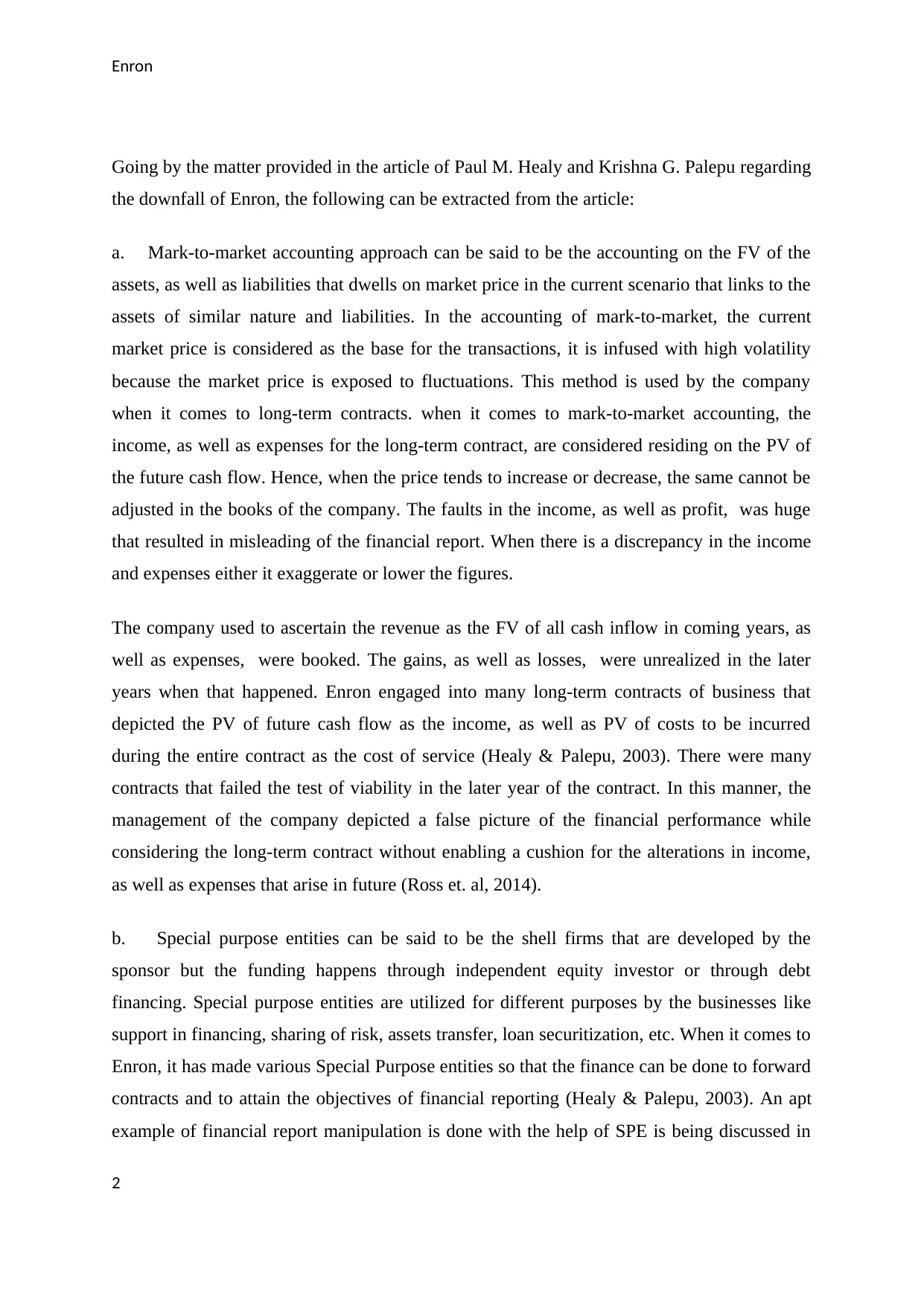
Enron
Going by the matter provided in the article of Paul M. Healy and Krishna G. Palepu regarding
the downfall of Enron, the following can be extracted from the article:
a. Mark-to-market accounting approach can be said to be the accounting on the FV of the
assets, as well as liabilities that dwells on market price in the current scenario that links to the
assets of similar nature and liabilities. In the accounting of mark-to-market, the current
market price is considered as the base for the transactions, it is infused with high volatility
because the market price is exposed to fluctuations. This method is used by the company
when it comes to long-term contracts. when it comes to mark-to-market accounting, the
income, as well as expenses for the long-term contract, are considered residing on the PV of
the future cash flow. Hence, when the price tends to increase or decrease, the same cannot be
adjusted in the books of the company. The faults in the income, as well as profit, was huge
that resulted in misleading of the financial report. When there is a discrepancy in the income
and expenses either it exaggerate or lower the figures.
The company used to ascertain the revenue as the FV of all cash inflow in coming years, as
well as expenses, were booked. The gains, as well as losses, were unrealized in the later
years when that happened. Enron engaged into many long-term contracts of business that
depicted the PV of future cash flow as the income, as well as PV of costs to be incurred
during the entire contract as the cost of service (Healy & Palepu, 2003). There were many
contracts that failed the test of viability in the later year of the contract. In this manner, the
management of the company depicted a false picture of the financial performance while
considering the long-term contract without enabling a cushion for the alterations in income,
as well as expenses that arise in future (Ross et. al, 2014).
b. Special purpose entities can be said to be the shell firms that are developed by the
sponsor but the funding happens through independent equity investor or through debt
financing. Special purpose entities are utilized for different purposes by the businesses like
support in financing, sharing of risk, assets transfer, loan securitization, etc. When it comes to
Enron, it has made various Special Purpose entities so that the finance can be done to forward
contracts and to attain the objectives of financial reporting (Healy & Palepu, 2003). An apt
example of financial report manipulation is done with the help of SPE is being discussed in
2
Going by the matter provided in the article of Paul M. Healy and Krishna G. Palepu regarding
the downfall of Enron, the following can be extracted from the article:
a. Mark-to-market accounting approach can be said to be the accounting on the FV of the
assets, as well as liabilities that dwells on market price in the current scenario that links to the
assets of similar nature and liabilities. In the accounting of mark-to-market, the current
market price is considered as the base for the transactions, it is infused with high volatility
because the market price is exposed to fluctuations. This method is used by the company
when it comes to long-term contracts. when it comes to mark-to-market accounting, the
income, as well as expenses for the long-term contract, are considered residing on the PV of
the future cash flow. Hence, when the price tends to increase or decrease, the same cannot be
adjusted in the books of the company. The faults in the income, as well as profit, was huge
that resulted in misleading of the financial report. When there is a discrepancy in the income
and expenses either it exaggerate or lower the figures.
The company used to ascertain the revenue as the FV of all cash inflow in coming years, as
well as expenses, were booked. The gains, as well as losses, were unrealized in the later
years when that happened. Enron engaged into many long-term contracts of business that
depicted the PV of future cash flow as the income, as well as PV of costs to be incurred
during the entire contract as the cost of service (Healy & Palepu, 2003). There were many
contracts that failed the test of viability in the later year of the contract. In this manner, the
management of the company depicted a false picture of the financial performance while
considering the long-term contract without enabling a cushion for the alterations in income,
as well as expenses that arise in future (Ross et. al, 2014).
b. Special purpose entities can be said to be the shell firms that are developed by the
sponsor but the funding happens through independent equity investor or through debt
financing. Special purpose entities are utilized for different purposes by the businesses like
support in financing, sharing of risk, assets transfer, loan securitization, etc. When it comes to
Enron, it has made various Special Purpose entities so that the finance can be done to forward
contracts and to attain the objectives of financial reporting (Healy & Palepu, 2003). An apt
example of financial report manipulation is done with the help of SPE is being discussed in
2
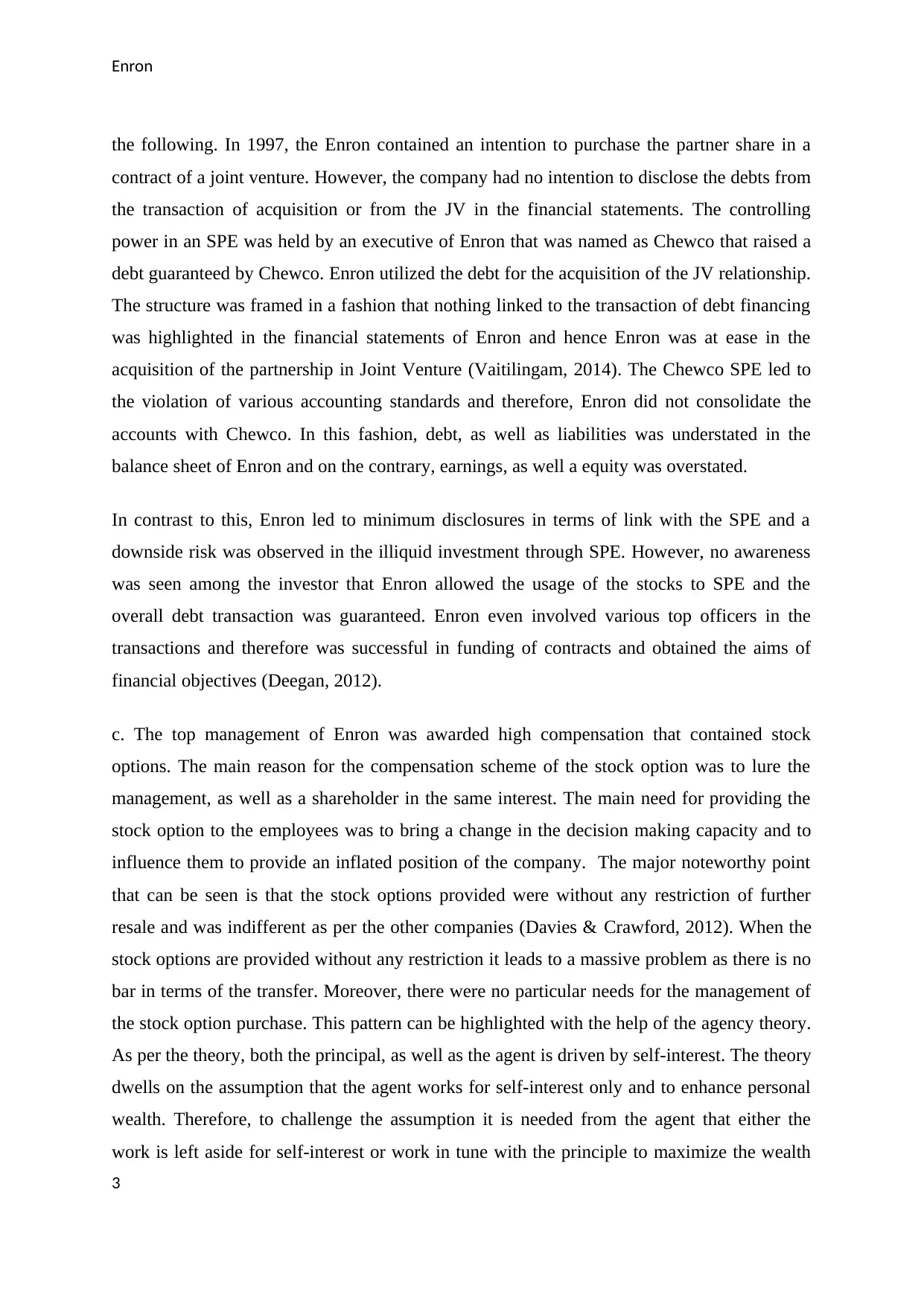
Enron
the following. In 1997, the Enron contained an intention to purchase the partner share in a
contract of a joint venture. However, the company had no intention to disclose the debts from
the transaction of acquisition or from the JV in the financial statements. The controlling
power in an SPE was held by an executive of Enron that was named as Chewco that raised a
debt guaranteed by Chewco. Enron utilized the debt for the acquisition of the JV relationship.
The structure was framed in a fashion that nothing linked to the transaction of debt financing
was highlighted in the financial statements of Enron and hence Enron was at ease in the
acquisition of the partnership in Joint Venture (Vaitilingam, 2014). The Chewco SPE led to
the violation of various accounting standards and therefore, Enron did not consolidate the
accounts with Chewco. In this fashion, debt, as well as liabilities was understated in the
balance sheet of Enron and on the contrary, earnings, as well a equity was overstated.
In contrast to this, Enron led to minimum disclosures in terms of link with the SPE and a
downside risk was observed in the illiquid investment through SPE. However, no awareness
was seen among the investor that Enron allowed the usage of the stocks to SPE and the
overall debt transaction was guaranteed. Enron even involved various top officers in the
transactions and therefore was successful in funding of contracts and obtained the aims of
financial objectives (Deegan, 2012).
c. The top management of Enron was awarded high compensation that contained stock
options. The main reason for the compensation scheme of the stock option was to lure the
management, as well as a shareholder in the same interest. The main need for providing the
stock option to the employees was to bring a change in the decision making capacity and to
influence them to provide an inflated position of the company. The major noteworthy point
that can be seen is that the stock options provided were without any restriction of further
resale and was indifferent as per the other companies (Davies & Crawford, 2012). When the
stock options are provided without any restriction it leads to a massive problem as there is no
bar in terms of the transfer. Moreover, there were no particular needs for the management of
the stock option purchase. This pattern can be highlighted with the help of the agency theory.
As per the theory, both the principal, as well as the agent is driven by self-interest. The theory
dwells on the assumption that the agent works for self-interest only and to enhance personal
wealth. Therefore, to challenge the assumption it is needed from the agent that either the
work is left aside for self-interest or work in tune with the principle to maximize the wealth
3
the following. In 1997, the Enron contained an intention to purchase the partner share in a
contract of a joint venture. However, the company had no intention to disclose the debts from
the transaction of acquisition or from the JV in the financial statements. The controlling
power in an SPE was held by an executive of Enron that was named as Chewco that raised a
debt guaranteed by Chewco. Enron utilized the debt for the acquisition of the JV relationship.
The structure was framed in a fashion that nothing linked to the transaction of debt financing
was highlighted in the financial statements of Enron and hence Enron was at ease in the
acquisition of the partnership in Joint Venture (Vaitilingam, 2014). The Chewco SPE led to
the violation of various accounting standards and therefore, Enron did not consolidate the
accounts with Chewco. In this fashion, debt, as well as liabilities was understated in the
balance sheet of Enron and on the contrary, earnings, as well a equity was overstated.
In contrast to this, Enron led to minimum disclosures in terms of link with the SPE and a
downside risk was observed in the illiquid investment through SPE. However, no awareness
was seen among the investor that Enron allowed the usage of the stocks to SPE and the
overall debt transaction was guaranteed. Enron even involved various top officers in the
transactions and therefore was successful in funding of contracts and obtained the aims of
financial objectives (Deegan, 2012).
c. The top management of Enron was awarded high compensation that contained stock
options. The main reason for the compensation scheme of the stock option was to lure the
management, as well as a shareholder in the same interest. The main need for providing the
stock option to the employees was to bring a change in the decision making capacity and to
influence them to provide an inflated position of the company. The major noteworthy point
that can be seen is that the stock options provided were without any restriction of further
resale and was indifferent as per the other companies (Davies & Crawford, 2012). When the
stock options are provided without any restriction it leads to a massive problem as there is no
bar in terms of the transfer. Moreover, there were no particular needs for the management of
the stock option purchase. This pattern can be highlighted with the help of the agency theory.
As per the theory, both the principal, as well as the agent is driven by self-interest. The theory
dwells on the assumption that the agent works for self-interest only and to enhance personal
wealth. Therefore, to challenge the assumption it is needed from the agent that either the
work is left aside for self-interest or work in tune with the principle to maximize the wealth
3

Enron
together with the personal wealth (Choi & Meek, 2011). When it comes to Enron, the
management can be defined as the agents that are provided with compensation of high stature
that includes stock options. It was the need to enhance the wealth of the public however, only
the financial performance was inflated without providing any sort of growth for the company.
4
together with the personal wealth (Choi & Meek, 2011). When it comes to Enron, the
management can be defined as the agents that are provided with compensation of high stature
that includes stock options. It was the need to enhance the wealth of the public however, only
the financial performance was inflated without providing any sort of growth for the company.
4
Secure Best Marks with AI Grader
Need help grading? Try our AI Grader for instant feedback on your assignments.
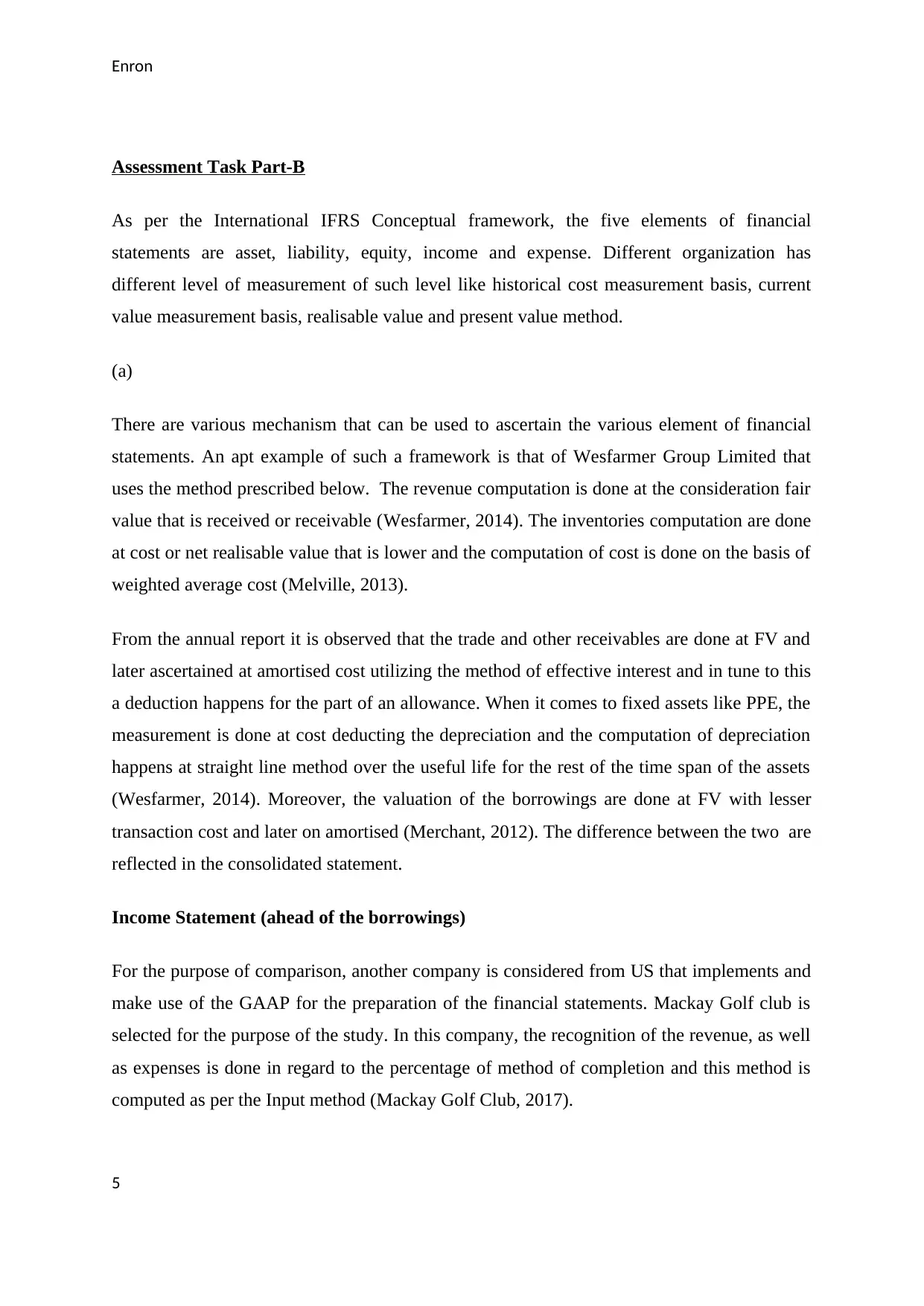
Enron
Assessment Task Part-B
As per the International IFRS Conceptual framework, the five elements of financial
statements are asset, liability, equity, income and expense. Different organization has
different level of measurement of such level like historical cost measurement basis, current
value measurement basis, realisable value and present value method.
(a)
There are various mechanism that can be used to ascertain the various element of financial
statements. An apt example of such a framework is that of Wesfarmer Group Limited that
uses the method prescribed below. The revenue computation is done at the consideration fair
value that is received or receivable (Wesfarmer, 2014). The inventories computation are done
at cost or net realisable value that is lower and the computation of cost is done on the basis of
weighted average cost (Melville, 2013).
From the annual report it is observed that the trade and other receivables are done at FV and
later ascertained at amortised cost utilizing the method of effective interest and in tune to this
a deduction happens for the part of an allowance. When it comes to fixed assets like PPE, the
measurement is done at cost deducting the depreciation and the computation of depreciation
happens at straight line method over the useful life for the rest of the time span of the assets
(Wesfarmer, 2014). Moreover, the valuation of the borrowings are done at FV with lesser
transaction cost and later on amortised (Merchant, 2012). The difference between the two are
reflected in the consolidated statement.
Income Statement (ahead of the borrowings)
For the purpose of comparison, another company is considered from US that implements and
make use of the GAAP for the preparation of the financial statements. Mackay Golf club is
selected for the purpose of the study. In this company, the recognition of the revenue, as well
as expenses is done in regard to the percentage of method of completion and this method is
computed as per the Input method (Mackay Golf Club, 2017).
5
Assessment Task Part-B
As per the International IFRS Conceptual framework, the five elements of financial
statements are asset, liability, equity, income and expense. Different organization has
different level of measurement of such level like historical cost measurement basis, current
value measurement basis, realisable value and present value method.
(a)
There are various mechanism that can be used to ascertain the various element of financial
statements. An apt example of such a framework is that of Wesfarmer Group Limited that
uses the method prescribed below. The revenue computation is done at the consideration fair
value that is received or receivable (Wesfarmer, 2014). The inventories computation are done
at cost or net realisable value that is lower and the computation of cost is done on the basis of
weighted average cost (Melville, 2013).
From the annual report it is observed that the trade and other receivables are done at FV and
later ascertained at amortised cost utilizing the method of effective interest and in tune to this
a deduction happens for the part of an allowance. When it comes to fixed assets like PPE, the
measurement is done at cost deducting the depreciation and the computation of depreciation
happens at straight line method over the useful life for the rest of the time span of the assets
(Wesfarmer, 2014). Moreover, the valuation of the borrowings are done at FV with lesser
transaction cost and later on amortised (Merchant, 2012). The difference between the two are
reflected in the consolidated statement.
Income Statement (ahead of the borrowings)
For the purpose of comparison, another company is considered from US that implements and
make use of the GAAP for the preparation of the financial statements. Mackay Golf club is
selected for the purpose of the study. In this company, the recognition of the revenue, as well
as expenses is done in regard to the percentage of method of completion and this method is
computed as per the Input method (Mackay Golf Club, 2017).
5
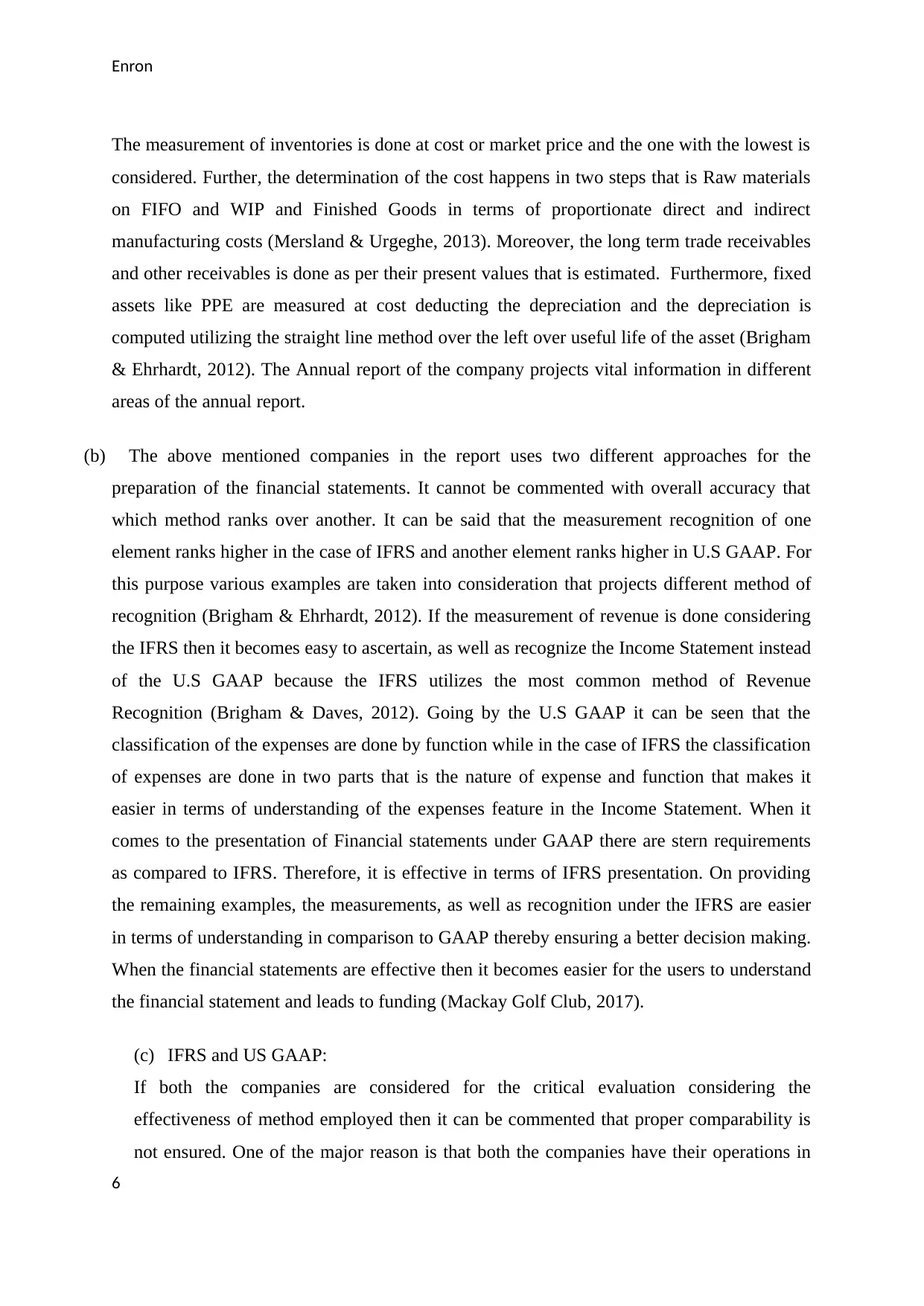
Enron
The measurement of inventories is done at cost or market price and the one with the lowest is
considered. Further, the determination of the cost happens in two steps that is Raw materials
on FIFO and WIP and Finished Goods in terms of proportionate direct and indirect
manufacturing costs (Mersland & Urgeghe, 2013). Moreover, the long term trade receivables
and other receivables is done as per their present values that is estimated. Furthermore, fixed
assets like PPE are measured at cost deducting the depreciation and the depreciation is
computed utilizing the straight line method over the left over useful life of the asset (Brigham
& Ehrhardt, 2012). The Annual report of the company projects vital information in different
areas of the annual report.
(b) The above mentioned companies in the report uses two different approaches for the
preparation of the financial statements. It cannot be commented with overall accuracy that
which method ranks over another. It can be said that the measurement recognition of one
element ranks higher in the case of IFRS and another element ranks higher in U.S GAAP. For
this purpose various examples are taken into consideration that projects different method of
recognition (Brigham & Ehrhardt, 2012). If the measurement of revenue is done considering
the IFRS then it becomes easy to ascertain, as well as recognize the Income Statement instead
of the U.S GAAP because the IFRS utilizes the most common method of Revenue
Recognition (Brigham & Daves, 2012). Going by the U.S GAAP it can be seen that the
classification of the expenses are done by function while in the case of IFRS the classification
of expenses are done in two parts that is the nature of expense and function that makes it
easier in terms of understanding of the expenses feature in the Income Statement. When it
comes to the presentation of Financial statements under GAAP there are stern requirements
as compared to IFRS. Therefore, it is effective in terms of IFRS presentation. On providing
the remaining examples, the measurements, as well as recognition under the IFRS are easier
in terms of understanding in comparison to GAAP thereby ensuring a better decision making.
When the financial statements are effective then it becomes easier for the users to understand
the financial statement and leads to funding (Mackay Golf Club, 2017).
(c) IFRS and US GAAP:
If both the companies are considered for the critical evaluation considering the
effectiveness of method employed then it can be commented that proper comparability is
not ensured. One of the major reason is that both the companies have their operations in
6
The measurement of inventories is done at cost or market price and the one with the lowest is
considered. Further, the determination of the cost happens in two steps that is Raw materials
on FIFO and WIP and Finished Goods in terms of proportionate direct and indirect
manufacturing costs (Mersland & Urgeghe, 2013). Moreover, the long term trade receivables
and other receivables is done as per their present values that is estimated. Furthermore, fixed
assets like PPE are measured at cost deducting the depreciation and the depreciation is
computed utilizing the straight line method over the left over useful life of the asset (Brigham
& Ehrhardt, 2012). The Annual report of the company projects vital information in different
areas of the annual report.
(b) The above mentioned companies in the report uses two different approaches for the
preparation of the financial statements. It cannot be commented with overall accuracy that
which method ranks over another. It can be said that the measurement recognition of one
element ranks higher in the case of IFRS and another element ranks higher in U.S GAAP. For
this purpose various examples are taken into consideration that projects different method of
recognition (Brigham & Ehrhardt, 2012). If the measurement of revenue is done considering
the IFRS then it becomes easy to ascertain, as well as recognize the Income Statement instead
of the U.S GAAP because the IFRS utilizes the most common method of Revenue
Recognition (Brigham & Daves, 2012). Going by the U.S GAAP it can be seen that the
classification of the expenses are done by function while in the case of IFRS the classification
of expenses are done in two parts that is the nature of expense and function that makes it
easier in terms of understanding of the expenses feature in the Income Statement. When it
comes to the presentation of Financial statements under GAAP there are stern requirements
as compared to IFRS. Therefore, it is effective in terms of IFRS presentation. On providing
the remaining examples, the measurements, as well as recognition under the IFRS are easier
in terms of understanding in comparison to GAAP thereby ensuring a better decision making.
When the financial statements are effective then it becomes easier for the users to understand
the financial statement and leads to funding (Mackay Golf Club, 2017).
(c) IFRS and US GAAP:
If both the companies are considered for the critical evaluation considering the
effectiveness of method employed then it can be commented that proper comparability is
not ensured. One of the major reason is that both the companies have their operations in
6
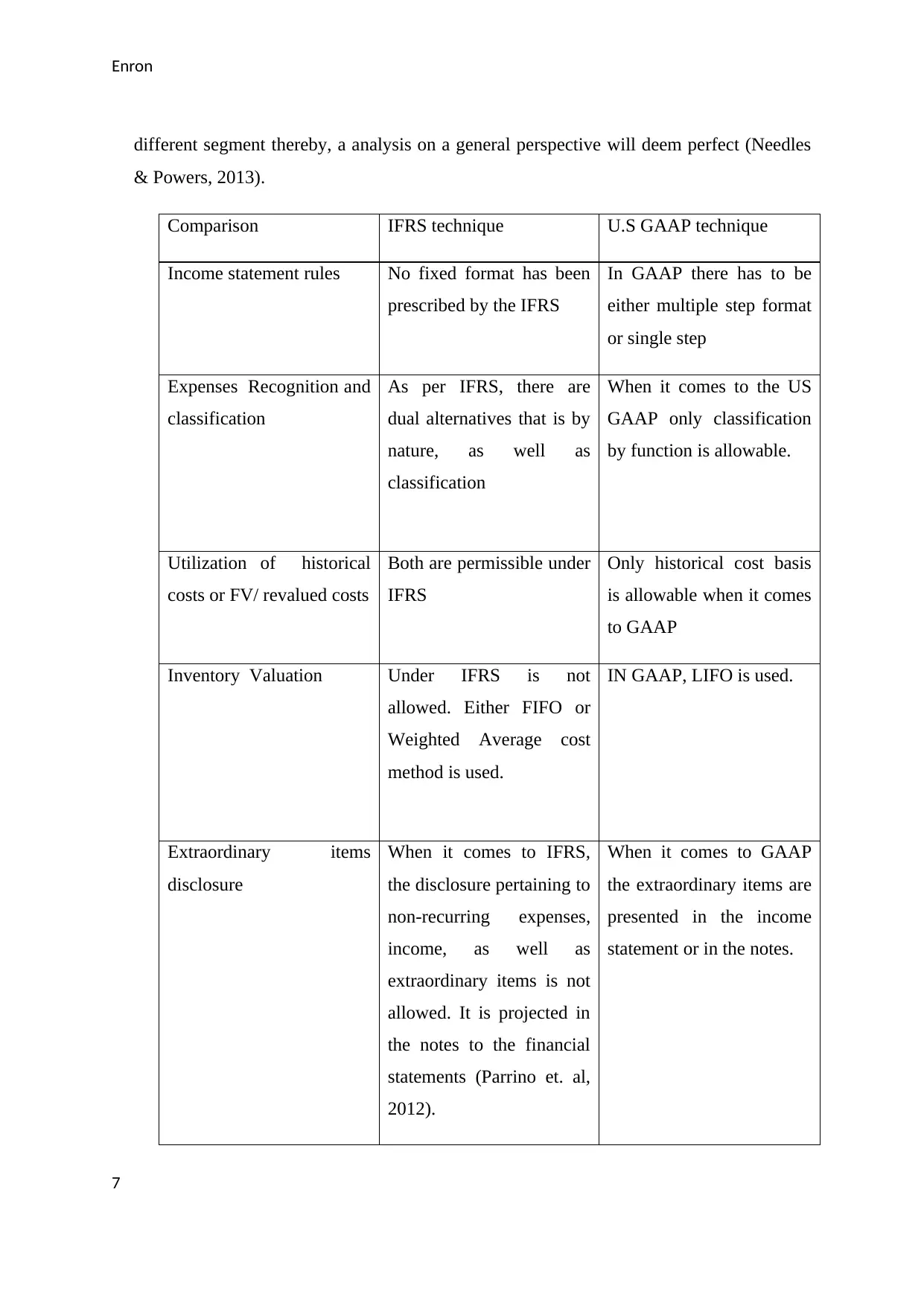
Enron
different segment thereby, a analysis on a general perspective will deem perfect (Needles
& Powers, 2013).
Comparison IFRS technique U.S GAAP technique
Income statement rules No fixed format has been
prescribed by the IFRS
In GAAP there has to be
either multiple step format
or single step
Expenses Recognition and
classification
As per IFRS, there are
dual alternatives that is by
nature, as well as
classification
When it comes to the US
GAAP only classification
by function is allowable.
Utilization of historical
costs or FV/ revalued costs
Both are permissible under
IFRS
Only historical cost basis
is allowable when it comes
to GAAP
Inventory Valuation Under IFRS is not
allowed. Either FIFO or
Weighted Average cost
method is used.
IN GAAP, LIFO is used.
Extraordinary items
disclosure
When it comes to IFRS,
the disclosure pertaining to
non-recurring expenses,
income, as well as
extraordinary items is not
allowed. It is projected in
the notes to the financial
statements (Parrino et. al,
2012).
When it comes to GAAP
the extraordinary items are
presented in the income
statement or in the notes.
7
different segment thereby, a analysis on a general perspective will deem perfect (Needles
& Powers, 2013).
Comparison IFRS technique U.S GAAP technique
Income statement rules No fixed format has been
prescribed by the IFRS
In GAAP there has to be
either multiple step format
or single step
Expenses Recognition and
classification
As per IFRS, there are
dual alternatives that is by
nature, as well as
classification
When it comes to the US
GAAP only classification
by function is allowable.
Utilization of historical
costs or FV/ revalued costs
Both are permissible under
IFRS
Only historical cost basis
is allowable when it comes
to GAAP
Inventory Valuation Under IFRS is not
allowed. Either FIFO or
Weighted Average cost
method is used.
IN GAAP, LIFO is used.
Extraordinary items
disclosure
When it comes to IFRS,
the disclosure pertaining to
non-recurring expenses,
income, as well as
extraordinary items is not
allowed. It is projected in
the notes to the financial
statements (Parrino et. al,
2012).
When it comes to GAAP
the extraordinary items are
presented in the income
statement or in the notes.
7
Paraphrase This Document
Need a fresh take? Get an instant paraphrase of this document with our AI Paraphraser
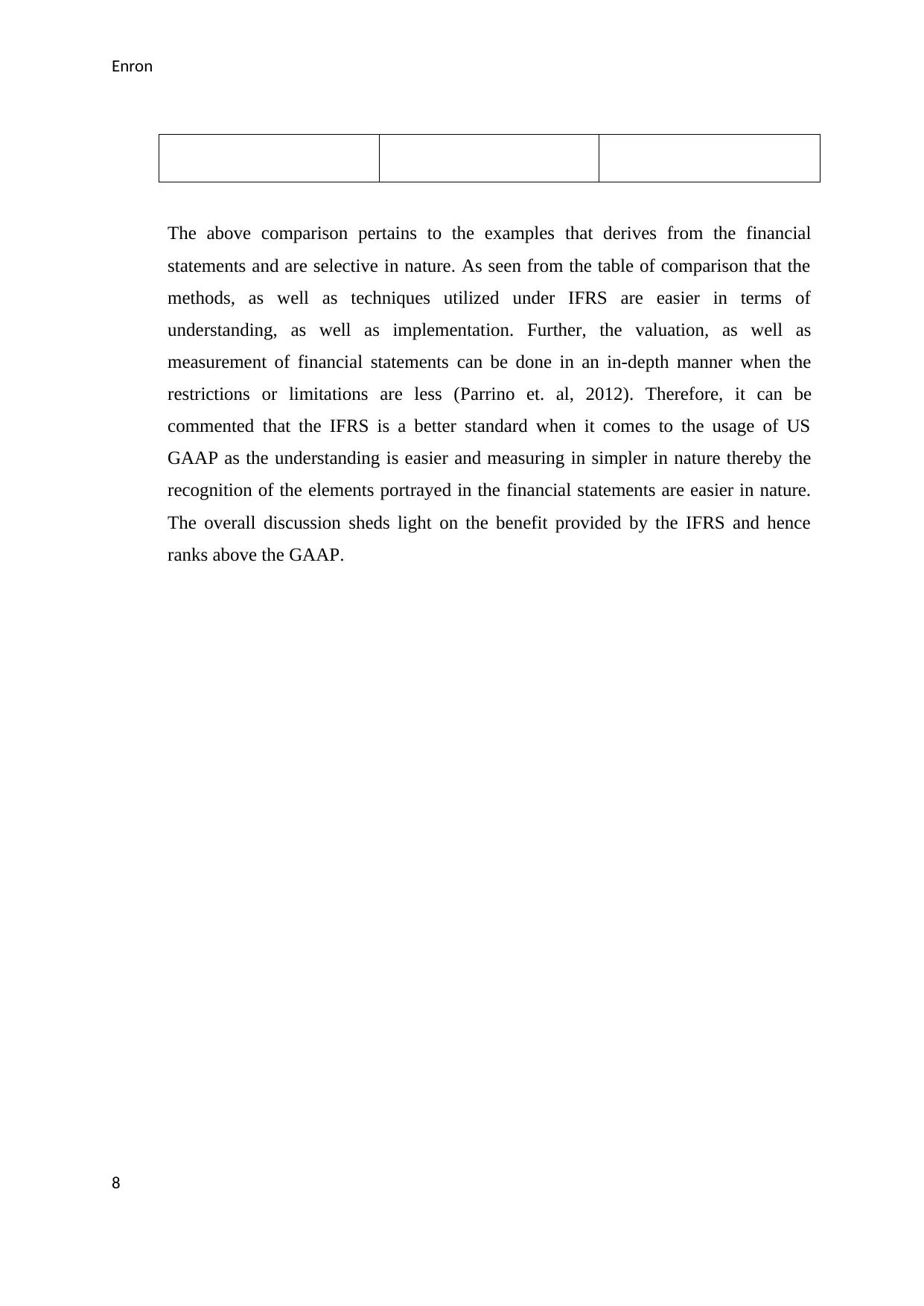
Enron
The above comparison pertains to the examples that derives from the financial
statements and are selective in nature. As seen from the table of comparison that the
methods, as well as techniques utilized under IFRS are easier in terms of
understanding, as well as implementation. Further, the valuation, as well as
measurement of financial statements can be done in an in-depth manner when the
restrictions or limitations are less (Parrino et. al, 2012). Therefore, it can be
commented that the IFRS is a better standard when it comes to the usage of US
GAAP as the understanding is easier and measuring in simpler in nature thereby the
recognition of the elements portrayed in the financial statements are easier in nature.
The overall discussion sheds light on the benefit provided by the IFRS and hence
ranks above the GAAP.
8
The above comparison pertains to the examples that derives from the financial
statements and are selective in nature. As seen from the table of comparison that the
methods, as well as techniques utilized under IFRS are easier in terms of
understanding, as well as implementation. Further, the valuation, as well as
measurement of financial statements can be done in an in-depth manner when the
restrictions or limitations are less (Parrino et. al, 2012). Therefore, it can be
commented that the IFRS is a better standard when it comes to the usage of US
GAAP as the understanding is easier and measuring in simpler in nature thereby the
recognition of the elements portrayed in the financial statements are easier in nature.
The overall discussion sheds light on the benefit provided by the IFRS and hence
ranks above the GAAP.
8
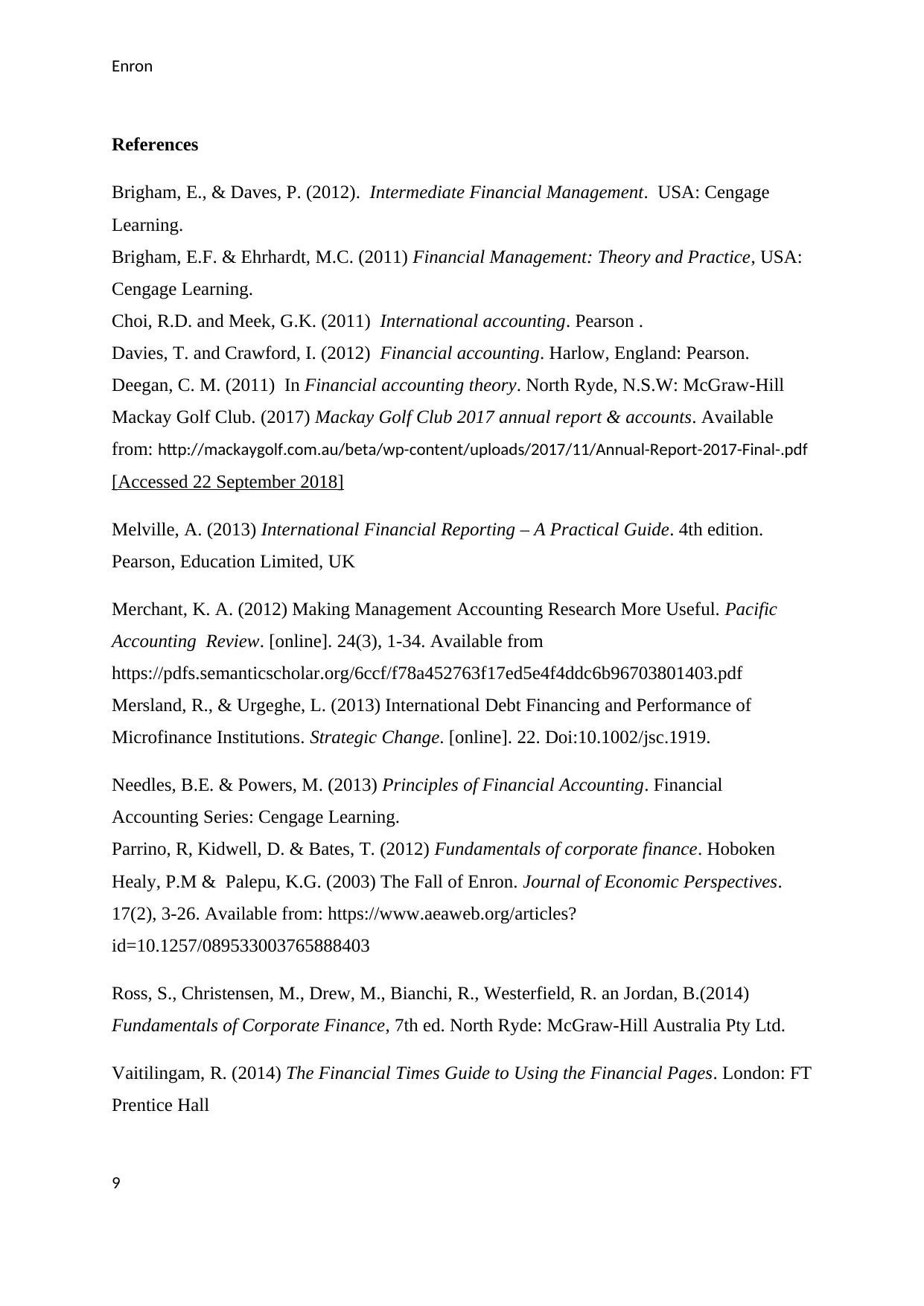
Enron
References
Brigham, E., & Daves, P. (2012). Intermediate Financial Management. USA: Cengage
Learning.
Brigham, E.F. & Ehrhardt, M.C. (2011) Financial Management: Theory and Practice, USA:
Cengage Learning.
Choi, R.D. and Meek, G.K. (2011) International accounting. Pearson .
Davies, T. and Crawford, I. (2012) Financial accounting. Harlow, England: Pearson.
Deegan, C. M. (2011) In Financial accounting theory. North Ryde, N.S.W: McGraw-Hill
Mackay Golf Club. (2017) Mackay Golf Club 2017 annual report & accounts. Available
from: http://mackaygolf.com.au/beta/wp-content/uploads/2017/11/Annual-Report-2017-Final-.pdf
[Accessed 22 September 2018]
Melville, A. (2013) International Financial Reporting – A Practical Guide. 4th edition.
Pearson, Education Limited, UK
Merchant, K. A. (2012) Making Management Accounting Research More Useful. Pacific
Accounting Review. [online]. 24(3), 1-34. Available from
https://pdfs.semanticscholar.org/6ccf/f78a452763f17ed5e4f4ddc6b96703801403.pdf
Mersland, R., & Urgeghe, L. (2013) International Debt Financing and Performance of
Microfinance Institutions. Strategic Change. [online]. 22. Doi:10.1002/jsc.1919.
Needles, B.E. & Powers, M. (2013) Principles of Financial Accounting. Financial
Accounting Series: Cengage Learning.
Parrino, R, Kidwell, D. & Bates, T. (2012) Fundamentals of corporate finance. Hoboken
Healy, P.M & Palepu, K.G. (2003) The Fall of Enron. Journal of Economic Perspectives.
17(2), 3-26. Available from: https://www.aeaweb.org/articles?
id=10.1257/089533003765888403
Ross, S., Christensen, M., Drew, M., Bianchi, R., Westerfield, R. an Jordan, B.(2014)
Fundamentals of Corporate Finance, 7th ed. North Ryde: McGraw-Hill Australia Pty Ltd.
Vaitilingam, R. (2014) The Financial Times Guide to Using the Financial Pages. London: FT
Prentice Hall
9
References
Brigham, E., & Daves, P. (2012). Intermediate Financial Management. USA: Cengage
Learning.
Brigham, E.F. & Ehrhardt, M.C. (2011) Financial Management: Theory and Practice, USA:
Cengage Learning.
Choi, R.D. and Meek, G.K. (2011) International accounting. Pearson .
Davies, T. and Crawford, I. (2012) Financial accounting. Harlow, England: Pearson.
Deegan, C. M. (2011) In Financial accounting theory. North Ryde, N.S.W: McGraw-Hill
Mackay Golf Club. (2017) Mackay Golf Club 2017 annual report & accounts. Available
from: http://mackaygolf.com.au/beta/wp-content/uploads/2017/11/Annual-Report-2017-Final-.pdf
[Accessed 22 September 2018]
Melville, A. (2013) International Financial Reporting – A Practical Guide. 4th edition.
Pearson, Education Limited, UK
Merchant, K. A. (2012) Making Management Accounting Research More Useful. Pacific
Accounting Review. [online]. 24(3), 1-34. Available from
https://pdfs.semanticscholar.org/6ccf/f78a452763f17ed5e4f4ddc6b96703801403.pdf
Mersland, R., & Urgeghe, L. (2013) International Debt Financing and Performance of
Microfinance Institutions. Strategic Change. [online]. 22. Doi:10.1002/jsc.1919.
Needles, B.E. & Powers, M. (2013) Principles of Financial Accounting. Financial
Accounting Series: Cengage Learning.
Parrino, R, Kidwell, D. & Bates, T. (2012) Fundamentals of corporate finance. Hoboken
Healy, P.M & Palepu, K.G. (2003) The Fall of Enron. Journal of Economic Perspectives.
17(2), 3-26. Available from: https://www.aeaweb.org/articles?
id=10.1257/089533003765888403
Ross, S., Christensen, M., Drew, M., Bianchi, R., Westerfield, R. an Jordan, B.(2014)
Fundamentals of Corporate Finance, 7th ed. North Ryde: McGraw-Hill Australia Pty Ltd.
Vaitilingam, R. (2014) The Financial Times Guide to Using the Financial Pages. London: FT
Prentice Hall
9
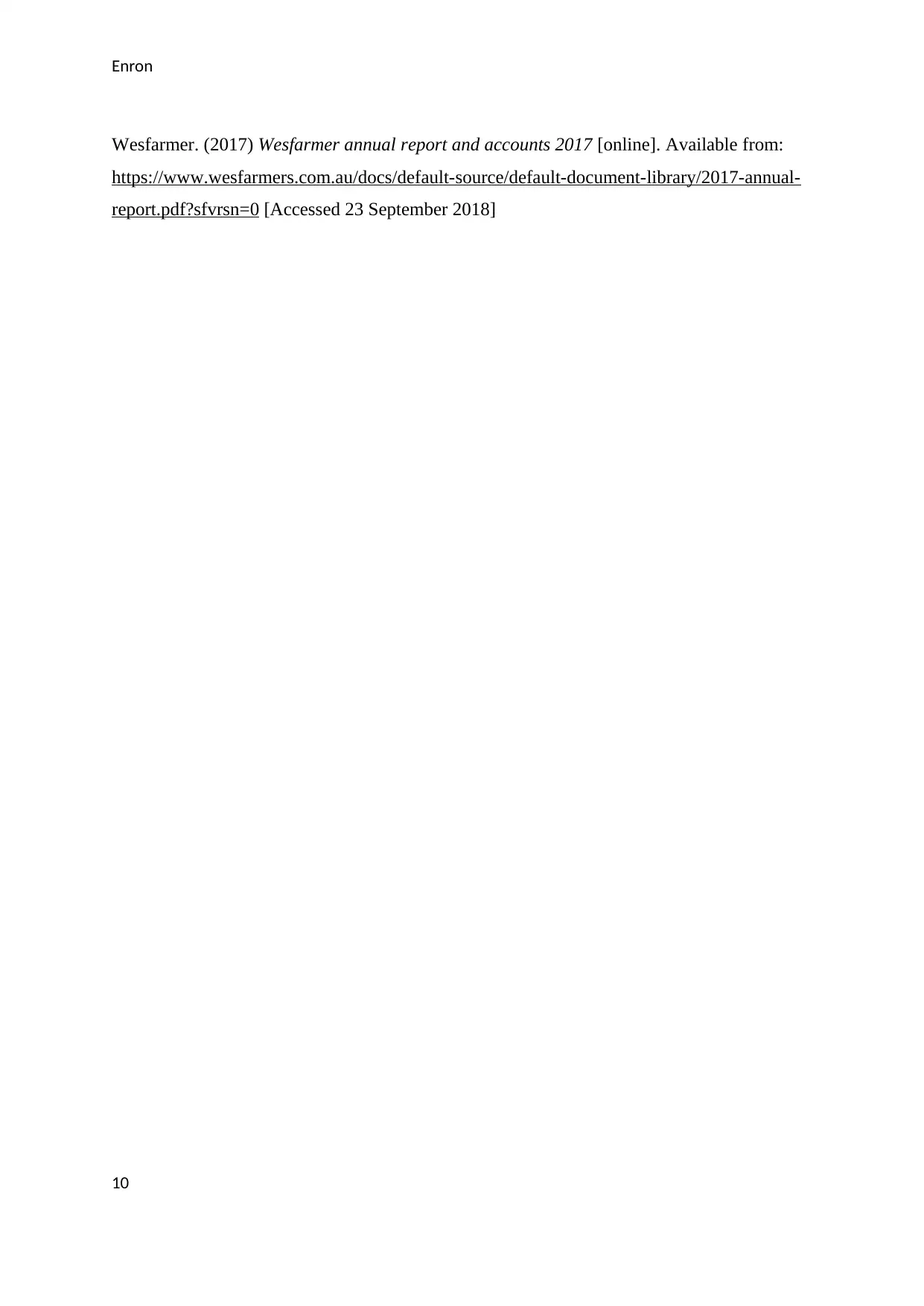
Enron
Wesfarmer. (2017) Wesfarmer annual report and accounts 2017 [online]. Available from:
https://www.wesfarmers.com.au/docs/default-source/default-document-library/2017-annual-
report.pdf?sfvrsn=0 [Accessed 23 September 2018]
10
Wesfarmer. (2017) Wesfarmer annual report and accounts 2017 [online]. Available from:
https://www.wesfarmers.com.au/docs/default-source/default-document-library/2017-annual-
report.pdf?sfvrsn=0 [Accessed 23 September 2018]
10
1 out of 10
Related Documents
Your All-in-One AI-Powered Toolkit for Academic Success.
+13062052269
info@desklib.com
Available 24*7 on WhatsApp / Email
![[object Object]](/_next/static/media/star-bottom.7253800d.svg)
Unlock your academic potential
© 2024 | Zucol Services PVT LTD | All rights reserved.





